This step by step diy woodworking project is about a 16×20 lean to pavilion plans. If you want to build a beautiful and sturdy pavilion for your backyard, these plans will guide you in a step by step manner. This pavilion is extra-sturdy, as it features a lot of braces on all corners. Take a look over the rest of our woodworking plans, if you want to get more building inspiration.
When buying the lumber, you should select the planks with great care, making sure they are straight and without any visible flaws (cracks, knots, twists, decay). Investing in cedar or other weather resistant lumber is a good idea, as it will pay off on the long run. Use a spirit level to plumb and align the components, before inserting the galvanized screws, otherwise the project won’t have a symmetrical look. If you have all the materials and tools required for the project, you could get the job done in about a day. See all my Premium Plans HERE.
Projects made from these plans
16×20 Lean to Pavilion – Free DIY Plans
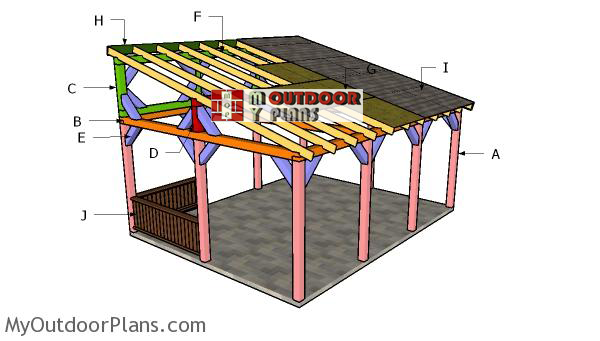
Building-a-lean-to-picnic-table
Cut & Shopping Lists
- A – 10 pieces of 6×6 lumber – 132″ long POSTS
- B – 2 pieces of 6×6 lumber – 240″ long, 4 pieces of 6×6 lumber – 192″ long TOP PLATES
- C – 20 pieces of 6×6 lumber – 26 1/4″ long BRACES
- 10 pieces of 6×6 lumber – 12′
- 2 pieces of 6×6 lumber – 20′
- 4 pieces of 6×6 lumber – 16′
- 5 pieces of 6×6 lumber – 10′
- 5″ screws, 8″ screws
- wood glue, stain/paint
- post hole digger
- post anchors (optional)
- beam to post connectors
- structural screws for connectors
- strong tie T
Tools
![]() Hammer, Tape measure, Framing square, Level
Hammer, Tape measure, Framing square, Level
![]() Miter saw, Drill machinery, Screwdriver, Sander
Miter saw, Drill machinery, Screwdriver, Sander
Time
Related
- PART 1: 16×20 Lean to Pavilion Plans
- PART 2: 16x20 Lean to PavilionRoof Plans
- PART 3: 16×20 Lean to Pavilion Railings Plans
How to build a 16×20 Lean to Pavilion

Fitting-the-posts—16×20-lean-to-pavilion
The first step of the project is to layout the posts for the 16×20 lean to pavilion. Use batter boards and string to determine the location of the posts. Apply the 3-4-5 rule to every corner of the pavilion, so you make sure they are right angled. Moreover measure the diagonals and make sure they are equal. Determining the location for the pavilion is essential, as you have to comply with the local building codes. Make sure the surface is level and remove the vegetation layer.
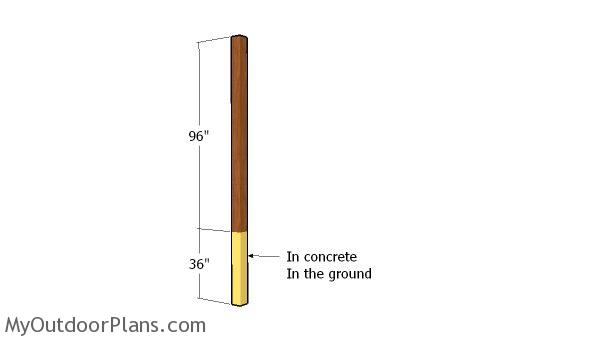
Posts
Dig 3′ deep holes into the ground with a post hole digger. Align the holes with attention and then fit form tubes. Fit the 6×6 posts with attention and align them using string. Use a spirit level to plumb the posts and then lock them into place with temporarily braces. Fill the tube forms with concrete and let it dry out for a few days. Setting the pressure treated/cedar posts in concrete is a lot better than using post anchors, as the posts will be locked in the concrete footers.
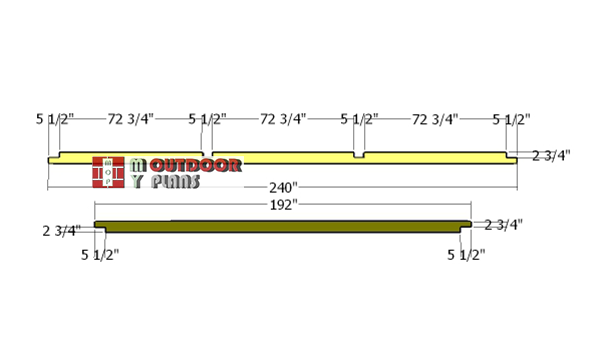
Top-plates—16×20-pavilion
Use 6×6 lumber for the top plates of the pavilion. Use a circular saw to make the notches to beams, as shown in the diagram. Make parallel cuts inside the marked areas and then remove the excess with a chisel. Smooth the surface with sandpaper.
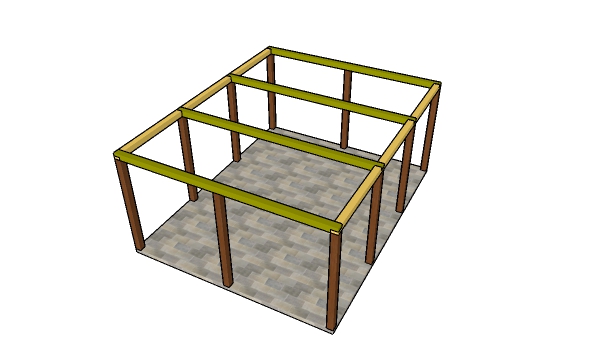
Fitting the top plates
Fit the top plates to the top of the posts. Plumb the posts with a spirit level and make sure the plates are horizontal. Check if the corners are square and align the edges with attention. Drill pilot holes through the plates and insert 8″ screws into the top of the posts.

Braces
Use 6×6 lumber for the braces. Use a miter saw to make 45 degree cuts at both ends of the braces.
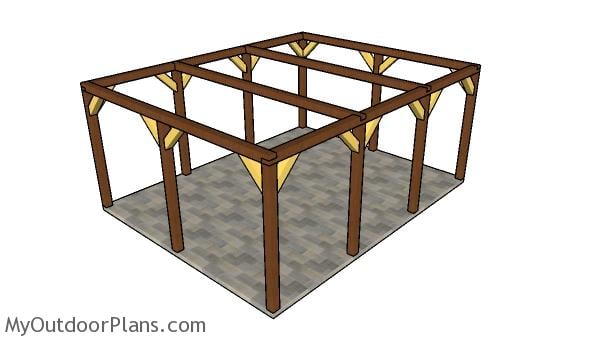
Fitting the braces
Last but not least, you need to attach the 6×6 braces to the structure of the pavilion, so you can enhance the rigidity. Align the edges with attention and then secure them into place tightly, with 5″ screws. Drill pilot holes before inserting the screws, to prevent the wood from splitting.

16×20 Lean to Pavilion Plans – Back view
You should check out PART 2 of the 16×20 pavilion plans, so you learn how to build the lean to roof. Check PART 3 of the project, so you learn how to build the railings.
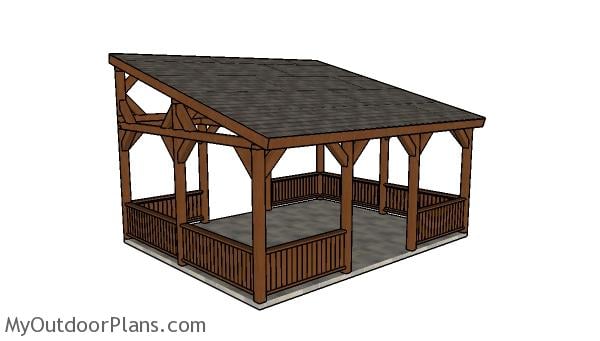
16×20 Lean to Pavilion Plans
Fill the holes with wood putty and let them dry out for a few hours. Smooth the surface with 100-220 grit sandpaper and remove the residues with a damp cloth.
Top Tip: Apply a few coats of paint or stain to the components, to enhance the look of the project. Make sure you take a look over the rest of my pergola/gazebo/pavilion plans HERE. See all my free woodworking plans (over 1000) HERE.
This woodworking project was about 16×20 outdoor pavilion plans free. If you want to see more outdoor plans, check out the rest of our step by step projects and follow the instructions to obtain a professional result. Feel free to SHARE my plans with your friends.


8 comments
Hi,I have a question. On the 16×20 lean to pavilion. What are the demensions if I built it with 4×4 instead of using 6×6
for fitting the post. Please advice.
Thanks ;
V/R Hector
That will change everything in terms of dimensions. I would need to redo the plans entirely. Can’t give you an answer in one sentence. In addition, I don’t recommend 4x4s for this pavilion size
How would the lumber list change if I wanted to make this 20×20? Thanks for your time.
It would be a whole different list.
Could you get away with doing a 16×20 lean but only using 6 posts? Just one in the middle of the 20ft run and nothing for the 16ft sides? It would change the entire plan I know, just curious if it really requires this much support? I’m looking for a more stripped down version of this.
Yes. Here: https://www.etsy.com/listing/837049830/16×24-lean-to-pavilion-plans (24 ft long, but similar)
Could you use 4×4 instead of 6×6?
I don’t recommend that